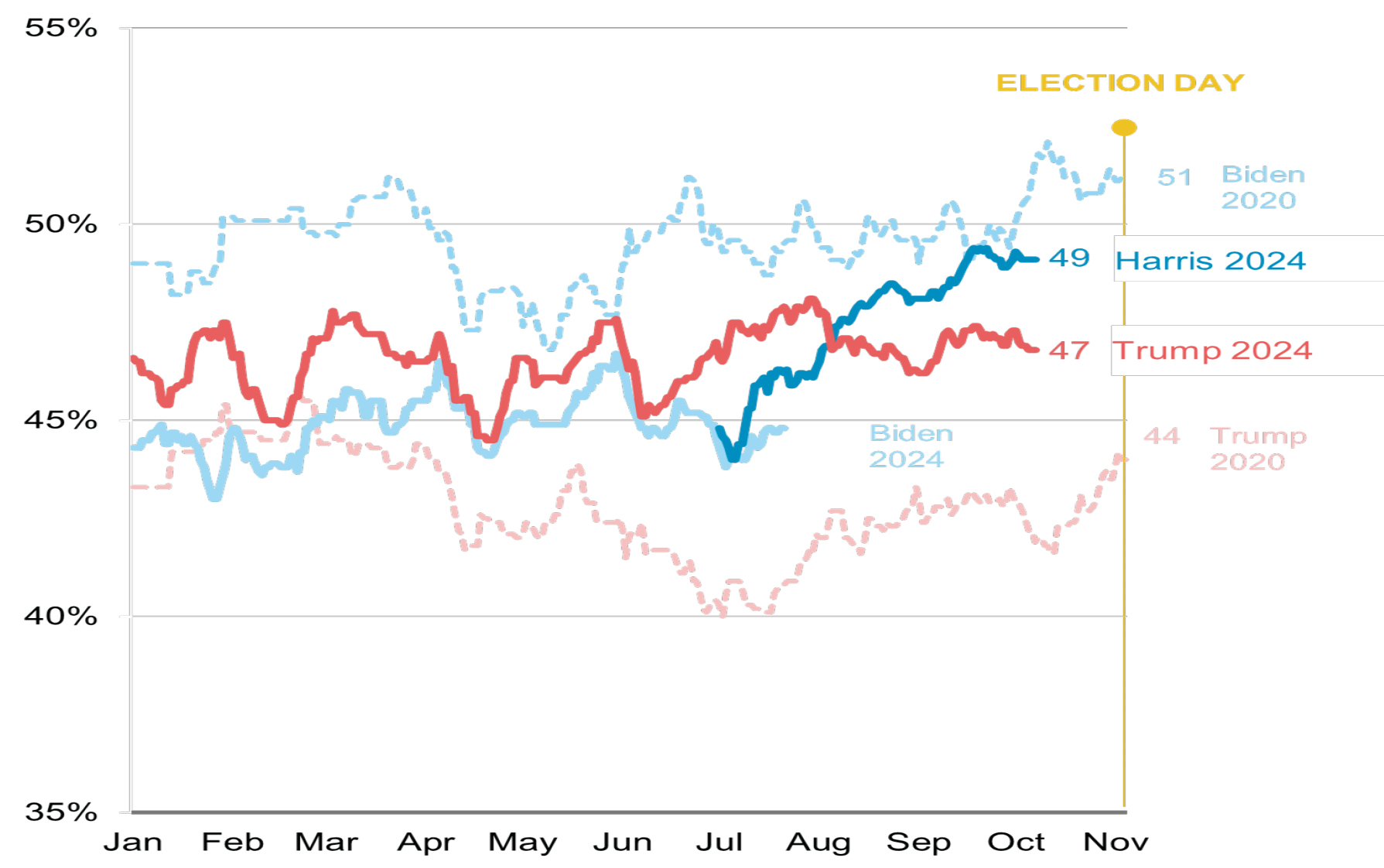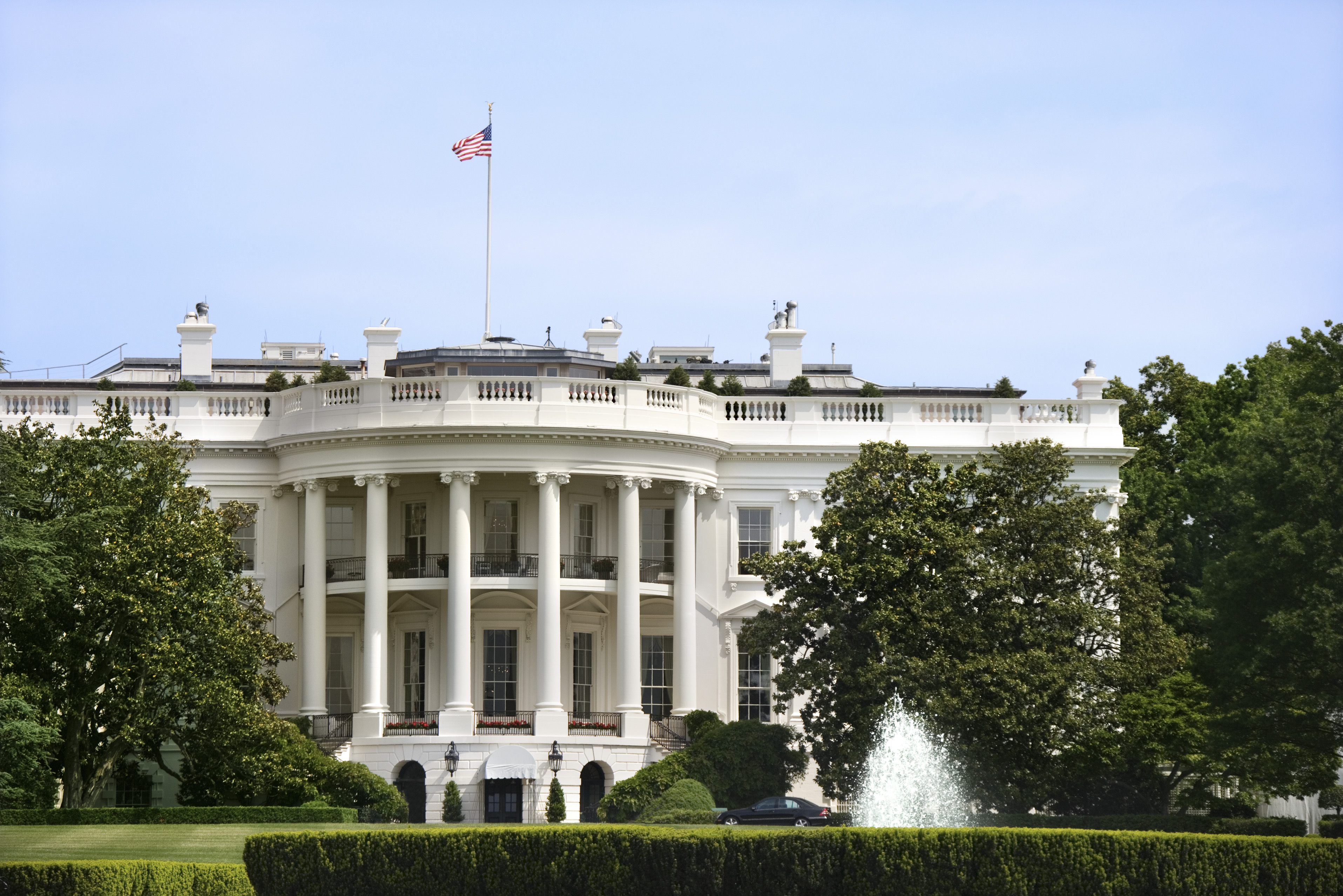The US election: too close to call
We are now entering the final act of this dramatic, and likely highly consequential, 60th presidential election. The polls are too close to call, yet the candidates’ positions could hardly be more polarised, leaving little room for nuanced analysis.
The state of play
Plot twists have not been in short supply: a failed assassination attempt; Biden’s withdrawal; Harris’s ascension; celebrity endorsements; another failed assassination attempt.
Since Harris was handed the baton in July – latterly winning (the largely procedural) Democratic nomination in August – she has presented a more youthful and coherent alternative to her predecessor. The first formal (and perhaps only) presidential debate in early September may not have been the decisive blow the Democrats were hoping for.
But Harris’s moderate message and tactful goading arguably reminded viewers of her opponent’s more impulsive nature. There are tentative signs that some of Trump’s loyal followers are questioning what may appear to be an increasingly radical and extreme ticket. The selection of JD Vance as Trump’s running mate also added to the somewhat unbalanced impression.
While polling momentum has shifted distinctly in Harris’s favour in recent months, today this still only amounts to a narrow two-point lead – essentially, the outlook remains a coin toss. Of course, the national polls can mean little in a race that may largely be determined by six key swing states – potentially, the views of fewer than 150,000 voters straddling the political centre. For now, this campaign – and the shape of the polls – appears to bear a greater resemblance to the 2016 race than to 2020. Hilary Clinton won the popular vote that year but failed to win the all-important Electoral College.
Plot twists have not been in short supply: a failed assassination attempt; Biden’s withdrawal; Harris’s ascension; celebrity endorsements; another failed assassination attempt."
The policies
What matters most for voters is the economy – jobs and inflation (James Carville’s enduring quote – “it’s the economy, stupid” – remains apt). But the wider context is complex and multifaceted. The candidates are at opposing ends of the policy spectrum on most matters, including immigration, climate change, foreign policy, regulation and, perhaps most pertinent of all, taxes. Hence the apparent polarisation.
The progressive and technocratically minded Harris arguably represents the status quo, favouring many of Biden’s policies, but with the addition of ‘pragmatic capitalism’– an economic pitch to the middle classes. She favours redistributive policies – higher spending, but also higher taxes – aimed at supporting middle-income America. Some polices are workable, if costly – for example, child tax credits and assisting first-time home buyers – while others look impractical, such as policies to tackle ‘price gouging’. To fund some of these measures, taxes on wealthy and higher income earners will rise, but so too will corporate taxes. The net effect on growth may be relatively muted (the boost to household spending power may offset its or less reversing the Trump cuts – would have a material impact on the earnings, and perhaps competitiveness, of US companies.
For Trump, it’s largely a return to a nostalgia-inducing ‘America First’ – a patchwork of populist, parochial policies: protectionism, immigration, deregulation, and lower taxes. The Make America Great Again (MAGA) economic agenda focuses on revitalising domestic manufacturing and levelling the playing field with China, which, its advocates believe, will lead to more jobs and faster growth. Lowering corporate tax rates (possibly to 15%) and extending the income tax cuts introduced in 2017 as part of the Tax Cut and Jobs Act (some of which Harris also proposes) would be positive (if expensive) for growth and might affect investors’ risk appetite.
There are many uncertainties involved in the MAGA agenda, however, not least the damage caused by higher duties. Talk of a 10% (possibly even 20%) import tariff on all goods, and a 60% tax on Chinese goods imports (nearly three times the average duty applied today), would likely hit consumption and raise inflation risk. The notion that tariffs could once again become the main source of income for the US treasury is fanciful. But populist ideas are not always based on careful analysis. In practice, raising tariff rates would be a thorny affair, and likely subject to legal challenge. Imposing higher duties on steel and aluminium tariffs as Trump did back in 2018 – on national security grounds – is one thing, but extending tariffs more broadly would likely require congressional support.
Despite the rhetoric, what Trump says and what he might do could be two quite different things. Don’t forget, back in 2016, he also threatened 10% tariffs on all imports, which failed to materialise. The trade deficit actually widened during his first term, perhaps because the main drivers of international trade are usually the rates of growth of domestic demand, not prices and costs.
Figure 1: 2024 US presidential election polls (average, %)
With less than a month to go, the latest opinion polls suggest Trump is just two percentage points behind Harris.

Source: Rothschild & Co, Bloomberg and RealClear Politics
Investment considerations
The uncertain outcome means that investors cannot easily ‘optimise’ portfolios, and we can only try to stay aware of the potential pitfalls as election day – and its aftermath – approaches.
A Trump victory would likely deliver a noisier and more dangerous world. But it could also, as after 2016, deliver a renewed boost to ‘animal spirits’ (and post-tax earnings). Nor, as some fear, can he single handedly reverse the post-war US-led liberal international order. Trump is a highly idiosyncratic candidate, but that need not lead to a worst-case investment outturn.
As for Harris, she represents the least risky option, and a continuation of more measured politics. But that does not mean she is likely to preside over an economic resurgence – particularly given some of the less business and investment-friendly policies being mooted.
The political complexion of the White House often matters less to capital markets than the business cycle."
Furthermore, and importantly, whoever ends up in the Oval Office may have little legislative support. A divided Congress remains the most likely outcome, suggesting that more extreme policy proposals would be constrained. The lack of fiscal headroom – which neither candidate fully acknowledges – may also limit some of the more costly handouts being considered.
In the narrow investment context, political noise may contribute to stock market volatility in the coming months – particularly if the result is delayed or contested – but the long-term relevance of the election may be overstated. As we’ve noted before, the political complexion of the White House often matters less to capital markets than the business cycle.
Figure 2 reminds us that US markets and the economy have often done better when there has been a Democrat in the White House – not necessarily because of their policies, but because Democratic presidents often had the good fortune to be in office in good times. To us, this suggests that the trajectories of growth, inflation and interest rates will matter more to stock and bond markets. Whoever wins this important race, those broader economic trends may yet remain constructive for capital markets.
Figure 2: Politics and the market
The US stock market and economy have often done better when a Democrat is in the White House, which may be due to good timing rather than any specific policies.
Past performance is not a guide to future performance and nothing in this blog constitutes advice. Although the information and data herein are obtained from sources believed to be reliable, no representation or warranty, expressed or implied, is or will be made and, save in the case of fraud, no responsibility or liability is or will be accepted by Rothschild & Co Wealth Management UK Limited as to or in relation to the fairness, accuracy or completeness of this document or the information forming the basis of this document or for any reliance placed on this document by any person whatsoever. In particular, no representation or warranty is given as to the achievement or reasonableness of any future projections, targets, estimates or forecasts contained in this document. Furthermore, all opinions and data used in this document are subject to change without prior notice.





